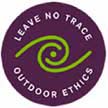

 |
Leave No Trace is a simple idea: we can visit wild places in a manner that records little or no sign of our passing. |
The Leave No Trace organization (Leave No Trace, Inc., which is associated with the National Outdoor Leadership School), is an international non-profit group dedicated to building awareness, appreciation, and respect for wildlands by promoting and inspiring thoughtful outdoor recreation through education, research, and partnerships. Leave No Trace is more than a campaign to clean up campsites; it is a program dedicated to inspiring respect and thoughtful use of public lands.
Leave No Trace hopes to influence the decisions people make while visiting public lands. The program strives to educate people about recreational impacts and techniques to minimize or prevent impacts. Leave No Trace is best understood as an educational and ethical program, not as a set of rules or regulations.
Leave No Trace uses experienced outdoor people to teach other people the skills and benefits of responsible wildland recreation. People experienced in their chosen form of recreation are the best resource for effectively communicating no-trace ideas to other people. To join the Leave No Trace organization or to learn more about their program, visit the Leave No Trace website or call 800-332-4100.
Seven Ideas About Leave-No-Trace Wilderness Travel
| Plan Ahead and Prepare | Be prepared. Take extra clothes to protect you from adverse weather (heat, cold, and precipitation). Take plenty of water (during summer, at least one gallon per day per person). During colder months, carry a sleeping bag in case you get stuck overnight. Learn first aid. Carry maps and know how to use them. Tell someone where you are going and when you plan to return. Prepare for your own rescue so that you don't need to call the rescue team. Learn about the areas (including rules and regulations) before visiting them by reading (books, websites) and talking to people who have been there. |
| Travel and Camp on Durable Surfaces | Stay on the main trail and walk single file to protect vegetation and prevent widening of trails and multiple trailing; don't cut switchbacks. Off trail, try to walk on hard surfaces (e.g., rocks and ridges) or in washes. Keep natural areas looking natural; don't trample flowers, shrubs, or cryptobiotic soil crusts. If damaged, cryptobiotic crusts might never grow back. Use existing campsites or camp on hard surfaces (e.g., flat rocks, bare dirt, or sandy areas) and keep your camp small. Camp at least 100 yards from roads, trails, and water sources. Campsites should not be set in places that compact or otherwise damage vegetation (e.g., meadows). Don't dig trenches in your campsite or alter the soil in any way. If you camp on a new site and clear the ground to make a place to sleep, kick a few rocks and sticks back over the area to make it look like it was never used. |
| Dispose of Waste Properly | Carry out all trash. Leave the wilderness cleaner than you found it. Urinate away from drainages. The Leave No Trace organization advocates putting toilet paper and feces in plastic bags and carrying it out. Otherwise, bury feces and paper in a small hole about 4-8 inches deep and 100 yards from water. Avoid the urge to burn toilet paper, a surprising number of wildfires get started this way. Keep water clean by not putting human waste, soap, food, or trash in water sources. |
| Leave What you Find | Treat resources with respect. When you find something interesting, enjoy it, but leave it for others to discover and enjoy too. Antiquities and artifacts on public lands are protected by law; leave them alone. Remember things with pictures. |
| Minimize Campfire Impacts | Campfires are not allowed in some backcountry areas (e.g., Mt. Charleston Wilderness Area, Zion, and the Grand Canyon), so eat cold food or cook with gas stoves. In areas where fires are permitted, use established fire rings and keep fires small. Be sure that the fire is out cold before you leave, and be sure to bury or scatter the cold ashes widely. If you can't find an established fire ring, don't make a new one. Rather, dig a shallow pit, and build the fire in the pit. You don't leave blackened stones, and you can cover up the pit and rehabilitate the site before you leave without a trace. Always be careful with fires. |
| Respect Wildlife | Watch wildlife from a distance and don't approach, feed, or follow them. Feeding wildlife is unhealthy and often illegal. Protect wildlife and your food by properly storing your food and trash. Where pets are allowed in the backcountry, be sure they are on leash and don't harass the wildlife. |
| Be Considerate of Other Visitors | Everyone in the wilderness is there to enjoy nature, but the fun you have should not interfere with other people. Avoid yelling and making loud noises, especially in canyons or across water where noise carries farther than you might think. |
Happy hiking! All distances, elevations, and other facts are approximate.
![]() ; Last updated 240323
; Last updated 240323
| Hiking Around Las Vegas | Glossary | Copyright, Conditions, Disclaimer | Home |